9 Instructions and precautions for injections
9 Instructions and precautions for injections
9 Instructions and precautions for injections
Create successful ePaper yourself
Turn your PDF publications into a flip-book with our unique Google optimized e-Paper software.
<strong>Instructions</strong> <strong>and</strong> Precautions<br />
<strong>for</strong> Injections<br />
WHEN TO INJECT AND WHEN NOT TO<br />
CHAPTER<br />
9<br />
Injections are not needed often. Most sicknesses that require medical treatment<br />
can be treated as well or better with medicines taken by mouth. Each year,<br />
millions of people—especially children—become ill, disabled, or die as a result of<br />
unnecessary <strong>injections</strong>. Combating misuse <strong>and</strong> overuse of medicines is as important<br />
to good health as vaccination, clean water, or the correct use of latrines. As a<br />
general rule:<br />
It is more dangerous to inject medicine<br />
than to take it by mouth.<br />
Injections should be used only when absolutely necessary. Except in<br />
emergencies, they should be given only by health workers or persons trained in<br />
their use.<br />
The only times medicines should be injected are:<br />
1. When the recommended medicine does not come in a <strong>for</strong>m that can be<br />
taken by mouth.<br />
2. When the person vomits often, cannot swallow, or is unconscious.<br />
3. In certain unusual emergencies <strong>and</strong> special cases (see the next page).<br />
WHAT TO DO WHEN THE DOCTOR PRESCRIBES<br />
INJECTIONS<br />
Doctors <strong>and</strong> other health workers sometimes prescribe <strong>injections</strong> when they are<br />
not needed. After all, they can charge more money <strong>for</strong> <strong>injections</strong>. They <strong>for</strong>get the<br />
problems <strong>and</strong> dangers of giving <strong>injections</strong> in rural areas.<br />
1. If a health worker or healer wants to give you an injection, be sure the<br />
medicine is appropriate <strong>and</strong> that she takes all the necessary <strong>precautions</strong>.<br />
2. If a doctor prescribes <strong>injections</strong>, explain that you live where no one is well<br />
trained to give <strong>injections</strong> <strong>and</strong> ask if it would be possible to prescribe a<br />
medicine to take by mouth.<br />
3. If a doctor wants to prescribe <strong>injections</strong> of vitamins, liver extract, or vitamin<br />
B12, but has not had your blood tested, tell him you would prefer to see<br />
another doctor.<br />
65
66<br />
Where There Is No Doctor 2011<br />
EMERGENCIES WHEN IT IS IMPORTANT TO GIVE INJECTIONS<br />
In case of the following sicknesses, get medical help as fast as you can. If there will<br />
be any delay in getting help or in taking the sick person to a health center, inject the<br />
appropriate medicine as soon as possible. For details of the doses, consult the pages<br />
listed below. Be<strong>for</strong>e injecting, know the possible side effects <strong>and</strong> take the needed<br />
<strong>precautions</strong> (see the Green Pages).<br />
For these sicknesses Inject these medicines<br />
Severe pneumonia (p. 171) penicillin in high doses (p. 351)<br />
Gangrene (p. 213)<br />
Infections after childbirth (p. 276) ampicillin (p. 352)<br />
<strong>and</strong> gentamicin (p.358) taken with<br />
metronidazole by mouth (p. 368).<br />
Tetanus (p. 182) penicillin (p. 351)<br />
<strong>and</strong> tetanus antitoxin (p. 388)<br />
Appendicitis (p. 93-94) ampicillin in high doses (p. 352) or<br />
Peritonitis (p. 93-94) <strong>and</strong> bullet wound penicillin (p. 352)<br />
or other puncture wound in the belly<br />
Poisonous snakebite (p. 105) antitoxins <strong>and</strong> antivenom (p. 387)<br />
Scorpion sting (in children, p. 106)<br />
Meningitis (p. 185) when you ampicillin (p. 352 <strong>and</strong> 353)<br />
do not suspect tuberculosis<br />
Meningitis (p. 185) ampicillin together with<br />
when you suspect tuberculosis streptomycin (p. 353) <strong>and</strong>,<br />
if possible, other TB<br />
medicines (p. 359)<br />
Vomiting (p. 161) when it antihistamines, <strong>for</strong> example,<br />
cannot be controlled promethazine (p. 385)<br />
Severe allergic reaction <strong>and</strong> epinephrine (Adrenalin, p. 385)<br />
allergic shock (p. 70) <strong>and</strong>, if possible, diphenhydramine<br />
(Benadryl, p. 386).<br />
The following chronic illnesses may require <strong>injections</strong>, but they are rarely<br />
emergencies. It is best to consult a health worker <strong>for</strong> treatment.<br />
Tuberculosis (p. 179 <strong>and</strong> 180) streptomycin (p. 361) together<br />
with other TB medicines (p. 359)<br />
Syphilis (p. 237) benzathine penicillin in very high<br />
doses (p. 238 <strong>and</strong> 352)<br />
Gonorrhea (p. 236) ceftriaxone (p. 359)<br />
spectinomycin (p. 359)
WHEN NOT TO INJECT:<br />
Never give <strong>injections</strong> if you can get medical help quickly.<br />
Never give an injection <strong>for</strong> a sickness that is not serious.<br />
Never give <strong>injections</strong> <strong>for</strong> a cold or the flu.<br />
Never inject a medicine that is not recommended <strong>for</strong> the illness you<br />
want to treat.<br />
Never give an injection unless your needle has been boiled or sterilized.<br />
Never inject a medicine unless you know <strong>and</strong> take all the recommended<br />
<strong>precautions</strong>.<br />
MEDICINES NOT TO INJECT<br />
In general, it is better never to inject the following:<br />
Where There Is No Doctor 2011<br />
1. Vitamins. Rarely are injected vitamins any better than vitamins taken by<br />
mouth. Injections are more expensive <strong>and</strong> more dangerous. Use vitamin pills or<br />
syrups rather than <strong>injections</strong>. Better still, eat foods rich in vitamins (see p. 111).<br />
2. Liver extract, vitamin B 12, <strong>and</strong> iron <strong>injections</strong> (such as Inferon). Injecting<br />
these can cause abscesses or dangerous reactions (shock, p. 70). Ferrous sulfate<br />
pills will do more good <strong>for</strong> almost all cases of anemia (p. 392).<br />
3. Calcium. Injected into a vein calcium is extremely dangerous, if not given<br />
very slowly. An injection in the buttock may cause a large abscess. Untrained<br />
people should never inject calcium.<br />
4. Penicillin. Nearly all infections that require penicillin can be effectively treated<br />
with penicillin taken by mouth. Penicillin is more dangerous when injected. Use<br />
injectable penicillin only <strong>for</strong> dangerous infections.<br />
5. Penicillin with streptomycin. As a general rule, avoid this combined<br />
medicine. Never use it <strong>for</strong> colds or the flu because it does not work. It can cause<br />
serious problems sometimes deafness or death. Also, overuse makes it more<br />
difficult to cure tuberculosis or other serious illness.<br />
6. Chloramphenicol or tetracycline. These medicines do as much or more<br />
good when taken by mouth. Use capsules or syrups rather than <strong>injections</strong> (p. 355<br />
<strong>and</strong> 356).<br />
7. Intravenous (I.V.) solutions. These should be used only <strong>for</strong> severe<br />
dehydration <strong>and</strong> given only by someone who is well trained. When not given<br />
correctly they can cause dangerous infections or death (p. 53).<br />
8. Intravenous medicines. There is so much danger in injecting any medicine in<br />
the vein that only well trained health workers should do it. However, never inject into<br />
a muscle (the buttock) medicine that says ‘<strong>for</strong> intravenous use only’. Also, never<br />
inject in the vein medicine that says ‘<strong>for</strong> intramuscular use only’.<br />
67
68<br />
Where There Is No Doctor 2011<br />
RISKS AND PRECAUTIONS<br />
The risks of injecting any medicines are (1) infection caused by germs entering with<br />
the needle <strong>and</strong> (2) allergic or poisonous reactions caused by the medicine.<br />
1. To lower the chance of infection when<br />
injecting, take great care that everything is<br />
completely clean. It is very important to boil the<br />
needle <strong>and</strong> syringe be<strong>for</strong>e injecting. After boiling,<br />
do not touch the needle with your fingers or with<br />
anything else.<br />
Never use the same needle <strong>and</strong> syringe to<br />
inject more than one person without boiling it<br />
again first. Carefully follow all of the instructions<br />
<strong>for</strong> injecting (see following pages).<br />
Be sure to wash your h<strong>and</strong>s well be<strong>for</strong>e<br />
preparing or giving <strong>injections</strong>.<br />
2. It is very important to know what reactions<br />
a medicine can produce <strong>and</strong> to take the<br />
recommended <strong>precautions</strong> be<strong>for</strong>e injecting.<br />
If any of the following signs of allergic or<br />
poisonous reaction appear, never give the same<br />
or similar medicine again:<br />
• hives (patchy swellings on skin)<br />
or a rash with itching<br />
• swelling anywhere<br />
• difficulty breathing<br />
• signs of shock (see p. 70)<br />
• dizzy spells with nausea<br />
(wanting to vomit)<br />
• problems with vision<br />
• ringing in the ears or deafness<br />
• severe back pain<br />
• difficulty urinating<br />
An abscess like this one comes from<br />
injecting with a needle that has not<br />
been well boiled <strong>and</strong> is not sterile<br />
(completely clean <strong>and</strong> germ free).<br />
Hives, or a rash with itching, can appear a few hours or<br />
up to several days after getting an injection. If the same<br />
medicine is given to the person again, it may cause a<br />
very severe reaction or even death (see p. 70).
This child was injected with a needle that<br />
was not sterile (boiled <strong>and</strong> completely free of<br />
germs).<br />
The dirty needle caused an infection that<br />
produced a large, painful abscess (pocket of<br />
pus) <strong>and</strong> gave the child a fever. Finally, the<br />
abscess burst as shown in the picture below.<br />
This child was injected <strong>for</strong> a cold. It would<br />
have been far better to give him no medicine<br />
at all. Rather than doing good, the injection<br />
caused the child suffering <strong>and</strong> harm.<br />
CAUTION: If possible, always give<br />
medicine by mouth instead of by<br />
injection especially to children.<br />
Where There Is No Doctor 2011<br />
To avoid problems like these:<br />
Inject only when absolutely<br />
necessary.<br />
♦ Boil the syringe <strong>and</strong> needle<br />
just be<strong>for</strong>e giving the injection<br />
<strong>and</strong> be very careful to keep<br />
them completely clean.<br />
♦ Use only the medicine<br />
recommended <strong>for</strong> the disease<br />
<strong>and</strong> be sure it is still in good<br />
condition <strong>and</strong> not spoiled.<br />
♦ Inject in the correct place.<br />
Do not inject infants <strong>and</strong><br />
small children in the buttock.<br />
Instead, inject them in the<br />
upper, outer part of the<br />
thigh. (Notice that this child<br />
was injected too low on the<br />
buttock, where it is possible to<br />
damage the nerve.)<br />
69
70<br />
Where There Is No Doctor 2011<br />
DANGEROUS REACTIONS FROM INJECTING<br />
CERTAIN MEDICINES<br />
The following groups of medicines sometimes produce a dangerous reaction called<br />
ALLERGIC SHOCK a short time after injection:<br />
• penicillins (including ampicillin)<br />
• antitoxins that are made from horse serum<br />
The risk of a serious reaction is greater in a person who has previously been injected<br />
with one of these medicines or with another medicine of the same group. This risk<br />
is especially great if the medicine caused an allergic reaction (hives, rash, itching,<br />
swelling, or trouble breathing) a few hours or days after the injection was given.<br />
To prevent a serious reaction from an injection:<br />
1. Use <strong>injections</strong> only when absolutely necessary.<br />
scorpion antivenom<br />
snake antivenom<br />
tetanus antitoxin<br />
2. Be<strong>for</strong>e injecting one of the medicines listed above, always have ready 2 ampules<br />
of epinephrine (Adrenalin, p. 385) <strong>and</strong> an ampule of an antihistamine like promethazine<br />
(Phenergan, p. 385) or diphenhydramine (Benadryl, p. 386).<br />
3. Be<strong>for</strong>e injecting, always ask if at any other time a similar injection caused itching or<br />
other reactions. If the person says yes, do not use this medicine or any other medicine of<br />
the same group, either injected or taken by mouth.<br />
4. In very serious cases, like tetanus or snakebite, if there is a good chance that<br />
the antitoxin might produce an allergic reaction (if the person suffers from allergies<br />
or asthma or has had horse serum be<strong>for</strong>e), inject promethazine or diphenhydramine<br />
15 minutes be<strong>for</strong>e giving the antitoxin: adults, 25 to 50 mg.; children, 10 to 25 mg.,<br />
depending on their size (see p. 386).<br />
5. After injecting any medicine, always stay with the person <strong>for</strong> 30 minutes to watch<br />
<strong>for</strong> any of the following signs of ALLERGIC SHOCK:<br />
• cool, moist, pale, gray skin (cold sweat)<br />
• weak, rapid pulse or heartbeat<br />
• difficulty breathing<br />
• loss of consciousness<br />
6. If these signs appear, immediately inject epinephrine (Adrenalin): adults, 1/2 ml.;<br />
children, 1/3 to 1/4 ml, depending on their size. Treat the person <strong>for</strong> SHOCK (see p. 77).<br />
Follow by giving an antihistamine in double the normal dose.<br />
{<br />
Rarely, ALLERGIC SHOCK may<br />
result from the sting of a wasp or bee or<br />
from medicine taken by mouth.
How to Avoid Serious Reactions<br />
to a Penicillin Injection<br />
1. For mild to moderate infections:<br />
give penicillin pills<br />
instead of <strong>injections</strong><br />
3. Be<strong>for</strong>e injecting penicillin:<br />
always have ampules<br />
of EPINEPHRINE<br />
(Adrenalin) ready.<br />
2. Be<strong>for</strong>e injecting ask the person:<br />
“Have you ever had a<br />
rash, itching, swelling,<br />
or trouble breathing<br />
after getting an<br />
injection of penicillin?”<br />
If the answer is yes, do not use penicillin,<br />
ampicillin, or amoxicillin. Use another<br />
antibiotic like erythromycin (p. 354) or a<br />
sulfonamide (p. 356).<br />
4. After injecting:<br />
5. If the person becomes very pale, his heart beats very fast,<br />
he has difficulty breathing, or he starts to faint, immediately<br />
inject into a muscle (or just under the skin—see p. 167) half<br />
an ampule of EPINEPHRINE (Adrenalin, a quarter of<br />
an ampule in small children) <strong>and</strong> repeat in 10 minutes<br />
if necessary.<br />
Where There Is No Doctor 2011<br />
stay with the person<br />
<strong>for</strong> at least 30 minutes.<br />
71
72<br />
Where There Is No Doctor 2011<br />
HOW TO PREPARE A SYRINGE FOR INJECTION<br />
Be<strong>for</strong>e preparing a syringe, wash h<strong>and</strong>s with soap <strong>and</strong> water.<br />
1. Take the syringe apart<br />
<strong>and</strong> boil it <strong>and</strong> the<br />
needle <strong>for</strong> 20 minutes.<br />
3. Put the needle <strong>and</strong> the syringe<br />
together, touching only the base of the<br />
needle <strong>and</strong> the button of the plunger.<br />
5. Fill the syringe.<br />
(Be careful that<br />
the needle does<br />
not touch the<br />
outside of the<br />
ampule.)<br />
8. Shake until the<br />
medicine dissolves.<br />
6. Rub the rubber of the<br />
bottle with clean cloth<br />
wet with alcohol or boiled<br />
water.<br />
9. Fill the syringe<br />
again.<br />
2. Pour out the boiled<br />
water without touching<br />
the syringe or the needle.<br />
4. Clean the ampule of distilled<br />
water well, then break off the top.<br />
7. Inject<br />
the distilled<br />
water into the<br />
bottle with<br />
the powdered<br />
medicine.<br />
10. Remove all air<br />
from the<br />
syringe.<br />
Be very careful not to touch the needle with anything—not even<br />
the cotton with alcohol. If by chance the needle touches your finger or<br />
something else, boil it again.
WHERE TO GIVE AN INJECTION<br />
Be<strong>for</strong>e injecting, wash h<strong>and</strong>s with soap <strong>and</strong> water.<br />
It is preferable to inject in the muscle of the buttocks, always in the upper outer<br />
quarter.<br />
HOW TO INJECT<br />
1. Clean the skin with soap <strong>and</strong> water<br />
(or alcohol—but to prevent severe<br />
pain, be sure the alcohol is dry be<strong>for</strong>e<br />
injecting).<br />
3. Be<strong>for</strong>e injecting, pull back<br />
on the plunger. (If blood<br />
enters the syringe, take<br />
the needle out <strong>and</strong> put it in<br />
somewhere else).<br />
Where There Is No Doctor 2011<br />
WARNING: Do not inject into an area of<br />
skin that is infected or has a rash.<br />
Do not inject infants <strong>and</strong> small children<br />
in the buttock. Inject them in the upper<br />
outer part of the thigh.<br />
4. If no blood enters,<br />
inject the medicine<br />
slowly.<br />
2. Put the needle straight in, all the<br />
way. (If it is done with one quick<br />
movement, it hurts less.)<br />
5. Remove the needle<br />
<strong>and</strong> clean the skin<br />
again.<br />
6. After injecting, rinse the syringe <strong>and</strong> needle at once. Squirt water through the<br />
needle <strong>and</strong> then take the syringe apart <strong>and</strong> wash it. Boil be<strong>for</strong>e using again.<br />
73
74<br />
Where There Is No Doctor 2011<br />
HOW INJECTIONS CAN DISABLE CHILDREN<br />
When used correctly, certain injected medicines, such as vaccinations, are<br />
important to protect a child’s health <strong>and</strong> prevent disability. But if <strong>injections</strong> are given<br />
with needles or syringes that are not sterilized, the <strong>injections</strong> may cause a serious<br />
infection. Unclean needles <strong>and</strong> syringes can spread germs that cause HIV or other<br />
serious diseases, such as hepatitis, from one person to another. Dirty needles <strong>and</strong><br />
syringes can also cause infections that lead to paralysis or death. Never inject more<br />
than 1 person with the same needle or syringe without disinfecting it first.<br />
Some injected medicines can cause dangerous allergic reactions, poisoning,<br />
deafness, or other harmful effects. For example, pregnant women are often given<br />
hormone <strong>injections</strong> to speed up childbirth <strong>and</strong> ‘give strength’—but these <strong>injections</strong> are<br />
dangerous <strong>for</strong> the mother <strong>and</strong> can cause brain damage or death of the baby.<br />
For more in<strong>for</strong>mation on how <strong>injections</strong> disable children, see Disabled Village<br />
Children, Chapter 3.<br />
For ideas on teaching people about the danger of unnecessary <strong>injections</strong>, see<br />
Helping Health Workers Learn, Chapters 18, 19, <strong>and</strong> 27.<br />
HOW TO CLEAN (STERILIZE) EQUIPMENT<br />
Many infectious diseases, such as HIV (see p. 399), hepatitis (see p. 172), <strong>and</strong><br />
tetanus (see p. 182), can spread from a sick person to a healthy person through the<br />
use of syringes, needles, <strong>and</strong> other instruments that are not sterile (this includes the<br />
instruments used <strong>for</strong> piercing ears, acupuncture, tattoos, or circumcision). Many skin<br />
infections <strong>and</strong> abscesses also start because of this. Any time the skin is cut or<br />
pierced, it should be done only with equipment that has been sterilized.<br />
Here are some ways to sterilize equipment:<br />
• Boil <strong>for</strong> 30 minutes. (If you do not have a clock,<br />
add 1 or 2 grains of rice to the water. When the rice is<br />
cooked, the equipment will be sterile.)<br />
• Or use pressure steaming <strong>for</strong> 30 minutes in<br />
a pressure cooker (or an autoclave).<br />
• Or soak <strong>for</strong> 20 minutes in a solution of 1 part chlorine bleach to 7 parts water, or<br />
in a solution of 70% ethanol alcohol. If possible, prepare these solutions fresh<br />
each day, because they lose their strength. (Be sure to sterilize the inside of a<br />
syringe by pulling some solution inside <strong>and</strong> then squirting it out.)<br />
When you are helping someone who has an infectious disease, wash your h<strong>and</strong>s<br />
often with soap <strong>and</strong> water.



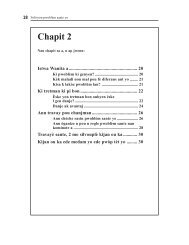
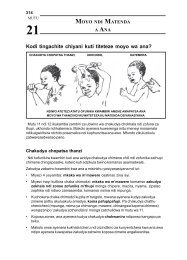
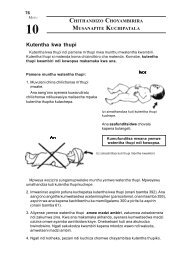
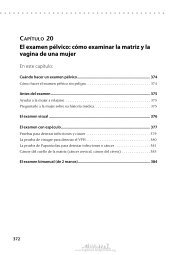
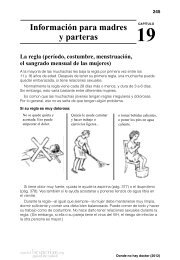
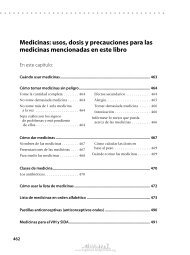
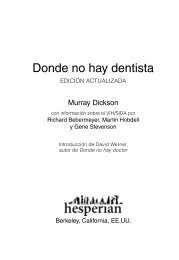
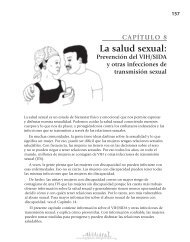
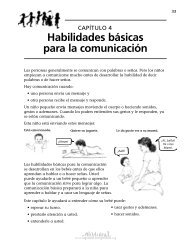

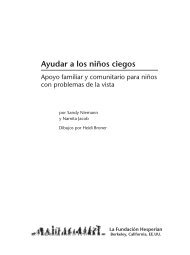
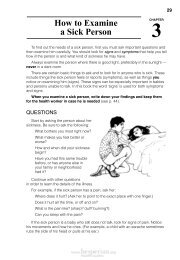
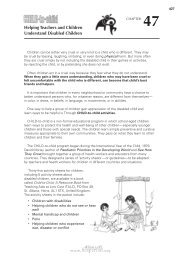
![kl/jf/ lgof]hg](https://img.yumpu.com/10041849/1/184x260/kl-jf-lgofhg.jpg?quality=85)
